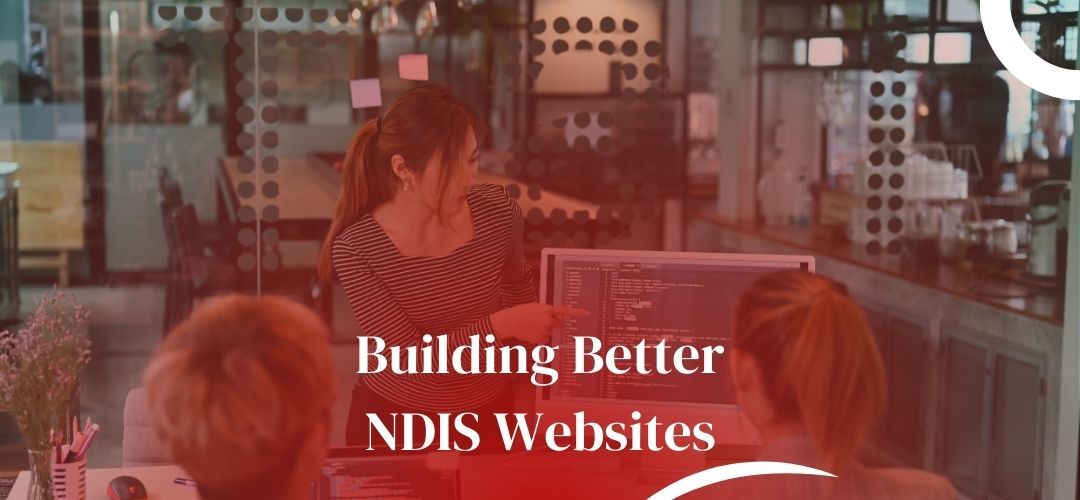SEO for NDIS Websites
SEO is a dynamic discipline that serves as the backbone for enhancing visibility, engagement, and reach for NDIS (National Disability Insurance Scheme) service providers' websites.
By understanding the essentials of SEO, NDIS providers can foster a robust online presence and achieve greater business success.
In a digital landscape saturated with information, distinguishing your services is vital. Here, SEO plays a critical role in ensuring that potential participants find your services swiftly amidst the internet's endless pages.
The Role of SEO for NDIS Websites
Picture your NDIS website as a bustling highway—without proper signage and roadmaps, your target audience might miss it entirely amid the traffic. This is where SEO, or search engine optimisation, steps in as your guiding light.
For NDIS service providers, SEO isn't just about being visible online; it's about being found by the people who need your services the most.
By integrating SEO strategies, you ensure that your website remains accessible, informative, and, truly, a beacon for potential participants and their families navigating the digital landscape.
The Future of SEO: Trends to Watch
The landscape of SEO is ever-evolving, and for NDIS providers, staying on top of these changes is crucial for maintaining a competitive edge. As we look towards the future, several key trends are poised to shape the SEO strategies for
NDIS websites.
1.
Voice Search Optimisation: As voice search technology becomes more prevalent, it's essential to adapt your SEO strategies accordingly. Optimising for voice search means incorporating more natural language queries and question-based keywords into your content. This can help NDIS providers connect more effectively with users seeking services through devices such as smart speakers.
To optimise for voice search effectively, consider the user's search intent. Focus on incorporating conversational keywords and long-tail phrases that reflect how people naturally speak. Here's how you can start:
- Embrace Natural Language: Adjust your content to include question phrases such as "how," "what," "where," and "why." Think about how you'd ask a question aloud.
- Provide Clear Answers: Aim to answer questions directly and succinctly. Use headings and lists to improve readability and make information easy to digest.
- Optimise for Featured Snippets: Aim to be the answer that Google features at the top of the search results by providing concise and authoritative content.
- Focus on Local SEO: Since many voice searches are local queries, ensure your NDIS website is optimised with local keywords to capture pertinent regional traffic.
- Improve Page Load Speed: Voice search users expect quick answers, so ensure your website loads swiftly and efficiently to maintain engagement.
2.
AI and Machine Learning: Artificial Intelligence and machine learning are transforming how search engines understand and rank content. By harnessing these technologies, NDIS providers can better predict user intent and deliver content that precisely meets their needs, enhancing both user satisfaction and search engine rankings.
AI and machine learning offer a pathway to more intelligent, data-driven SEO strategies. Utilising AI-powered tools, businesses can delve into deeper keyword insights and trends, identifying opportunities your competitors may overlook.
By understanding these patterns, you can fine-tune your content strategy to deliver highly relevant, engaging material.
As a result, NDIS businesses can not only improve their SEO rankings but also enhance their overall online presence, connecting more effectively with their target audience.
3.
Emphasis on User Experience (UX): Google is increasingly focusing on user experience as a ranking factor. This trend advocates for a seamless, engaging, and accessible online experience. Ensuring your NDIS site is user-friendly, with quick load times and intuitive navigation, is imperative for future-proofing your SEO efforts.
Integrating user experience (UX) into your SEO strategy doesn’t just enhance visibility; it fosters growth for your NDIS business on multiple fronts. At the heart of UX-based SEO, there’s a focus on understanding the specific needs of your audience. By doing so, you're better positioned to create content and interfaces that resonate, encouraging deeper engagement and longer site visits. These actions signal to search engines that your site is relevant and valuable, thereby increasing your ranking potential.
By prioritising accessibility, you're not only complying with best practices but also expanding your reach to a broader audience, including those with disabilities who require assistive technologies. An accessible website is attractive to search engines looking for comprehensive solutions for users, effectively broadening your customer base.
Engagement is further amplified when users find your site easy to navigate and quick to load, minimising frustration and reducing bounce rates. As they explore your content more extensively, they're also more likely to share information with others, increasing your visibility through word-of-mouth recommendations.
Focusing on a UX-based approach in your SEO strategy equips your NDIS business not only with a better search ranking but also a loyal, satisfied clientele, laying the foundation for sustained growth and success in the digital landscape.
4. Local SEO and Personalisation: Local SEO remains a critical component for NDIS providers, as many participants prefer nearby services. Personalising your SEO strategies by tailoring content and keywords to specific regions can increase local visibility and drive more qualified traffic to your site.
Enhancing your website's local SEO involves a combination of strategies aimed at boosting visibility in your operational area. Here's how you can do it:
- Optimise Google My Business:
Start by claiming and verifying your Google My Business profile. Ensure your business name, address, and phone number (NAP) are accurate and consistent across all platforms and listings. Frequently update this profile with posts, offers, and announcements to stay relevant.
Moreover, optimised GMB profiles receive 5x more views.
On average, 56% of actions on GMB listings result in a direct website visit, indicating a strong engagement level.
- Use Local Keywords: Incorporate local keywords naturally within your website’s content. Use terms that reflect your service area, like city or region names, alongside your core services. For example, "NDIS support services in Sydney.
Utilising local keywords can significantly enhance your SEO strategy, driving more traffic from users who are specifically searching for services you provide.
By targeting local search queries, NDIS websites can improve their visibility among nearby users, which is crucial given that half of all local mobile searchers visit a store within one day according to research.
- Leverage Local Backlinks:
Build a network of backlinks from local businesses and community websites. Participate in local events or sponsorships and initiate partnerships with complimentary services to get quality backlinks. Gaining local backlinks can significantly influence your SEO rankings and community presence. NDIS providers leveraging local SEO, including backlinks, have seen a marked improvement in their online visibility. This is because search engines view these local backlinks as a trustworthy endorsement of your site. Here is a guide of type of websites that you can try to get backlinks from.
- Government Websites: Secure backlinks from local government pages that offer directories for service providers.
For example, Department of Social Services
https://www.dss.gov.au/
- NDIS-Related Associations: Partner with associations such as the National Disability Services for potential backlink opportunities.
For example,
https://ndis.gov.au/
- Local Chambers of Commerce: Joining and engaging with your local chamber can provide backlink opportunities on their directories.
For example,
- Educational Institutions: Collaborating with universities and colleges for research or community events can offer high-quality backlinks.
For example,
- Local News Outlets: Submitting press releases to reputable news stations increases your likelihood of being sourced in articles.
For example,
- Industry-Specific Blogs: Write guest posts or provide insights to bloggers who specialise in disability or health-related topics in Australia.
For example,
- Local Charities and Nonprofits: Developing partnerships with these organisations can lead to mutually beneficial backlinking opportunities.
For example,
When these links come from reputable and locally-relevant sources, they not only enhance your site's authority but also signal to search engines that your content is beneficial to the local community. This, in turn, can lead to higher organic search results for local search queries, making it easier for NDIS participants to find your services.
By building relationships with local businesses and organisations, you're not just improving your SEO but also fostering community connections. This dual benefit plays a crucial role in solidifying your position as a trusted NDIS provider in your locality. Remember, quality over quantity is key; always opt for genuine, relevant backlinks over a large number of low-quality links.
- Engage on Local Directories and Review Sites: Ensure your NDIS business is listed on important local directories and platforms like Yellow Pages or Facebook groups. Encourage satisfied clients to leave positive reviews, which enhance credibility and improve local rankings. To effectively engage on local directories and review sites, follow these practical steps:
- Research Local Directories: Identify directories relevant to your location and industry. Aim to list your services on at least 3-5 high-traffic directories.
- Claim Your Listings:
Ensure that you claim and verify your business listing on each platform. This will allow you to manage your information and interact with users.
- Consistent NAP Information:
Ensure your Name, Address, and Phone number (NAP) are consistent across all listings. Consistency builds trust and improves SEO.
- Solicit Reviews: Politely ask satisfied clients to leave reviews. Provide them with simple instructions on how to do so, without exerting pressure.
- Engage with Reviews:
Regularly check reviews and respond professionally, whether reviews are positive or negative. Engagement shows that you value client feedback.
- Monitor Reviews and Listings Regularly: Schedule a monthly review of your listings to ensure information remains accurate and to thank clients for their feedback.
Engaging in Facebook group conversations can significantly boost your local SEO efforts and enhance your outreach to NDIS participants. First, identify groups that are relevant to both your industry and locality. Join them as a professional voice, and introduce your business thoughtfully.
Be sure to listen more than you speak initially. Understand the group's dynamic, observe ongoing discussions, and identify key pain points or interests that align with your services. When ready to contribute, begin by offering valuable insights, sharing informative content, or answering group members' questions. Avoid overtly promotional language—a helpful approach garners far more trust and interest.
Consistently engage with members by liking, commenting on, or sharing relevant posts. Share success stories, blog posts, or inner workings of how NDIS services can transform lives, ensuring that your contributions are aligned with the group’s focus. Encouraging meaningful conversations fosters relationships and establishes your presence as both approachable and knowledgeable.
Set notifications for your involvement, so you're promptly aware of replies or follows-ups. Regular engagement keeps your brand front-of-mind, and can lead to offline connections or direct inquiries regarding your services.
- Create Geotargeted Content:
Craft blog posts, articles, or news updates focusing on local events, community news, or region-specific information. This positions you not only as a service provider but also as a resource for local insights. Here is a list of sample article topics, new updates with a focus on local and community interest and news.
- Exploring Innovative NDIS Support Techniques: Delve into cutting-edge approaches NDIS providers are adopting to enhance participant experiences and outcomes.
- Success Stories: NDIS Impact on Lives: Share narratives from NDIS participants who have achieved significant personal milestones with the assistance of tailored services.
- Demystifying NDIS Funding Models: Provide a comprehensive breakdown of different NDIS funding streams, helping participants navigate their financial options effectively.
- Intersection of Technology and NDIS Services: Examine how emerging technologies are transforming the delivery of disability services under the NDIS framework.
- Community Building Through NDIS Initiatives: Highlight projects or programs that focus on fostering community inclusion and participation among NDIS participants.
- Navigating the NDIS: Top Tips for New Participants: Offer practical advice and insights for individuals just beginning their journey with NDIS services.
- Sydney's Accessible Parks and Recreation: Explore recreational areas and parks in Sydney that are best suited for individuals with disabilities. Highlight accessibility features and community events like "Inclusive Picnic Day" hosted at Darling Harbour.
- Melbourne's Latest Disability-Friendly Expo: Discover the newest assistive technology innovations emerging from Brisbane. Detail equipment showcases or local seminars, such as those presented by the Brisbane Assistive Technology Expo.
- Spotlight on Disability Services in Greater Brisbane: Feature profiles of standout disability service providers in the Brisbane region, emphasising unique offerings or success stories. Include community initiatives that foster inclusivity and empowerment.
- Sydney's Top Accessible Dining Options: List top-rated restaurants in Sydney renowned for their accessibility. Include interviews with restaurant owners who advocate for inclusivity and descriptions of features like modified menus or accessible seating arrangements.
- Cultural Events for All Abilities in Sydney: Promote inclusive cultural events in Brisbane, such as art exhibitions or theatre productions that welcome audiences of all abilities. Provide insights into what makes the events particularly accessible and enriching.
Implementing these strategies can help bolster your NDIS website’s local SEO, making your services easier to find by nearby participants. Optimising your presence in local search results ensures you’re always within reach of potential clients who need your support the most.
By understanding current trends, you can implement best practices that will enhance the visibility and performance of NDIS websites. Below is a table summarising key SEO statistics for 2024:
| Google's market share in search engines |
91.9% |
| Organic search traffic share |
53% |
| Websites with mobile optimisation |
88% |
| Pagespeed factor in ranking |
25% |
| Influence of quality content |
57% |
With these statistics in mind, it’s clear that factors such as Google's dominance, the importance of mobile optimisation, and high-quality content are imperative. As you proceed, keep in mind these guiding principles: focus on page speed, ensure mobile optimisation, and prioritise quality content.
Optimising Your Site Structure for Better Crawlability
Imagine your website as a meticulously plotted map, guiding search engines through its virtual terrain with ease. The structure of your site isn't just about aesthetics or navigation
—it's the foundation of how effectively search engines can crawl and index your content. By structuring your website logically, using heading tags <h1> through <h6>, you create a seamless workflow for search engine spiders. This not only improves your site's crawlability but also contributes to your site's overall SEO performance.
In addition to this, consider implementing a clear breadcrumb trail that reflects your site's hierarchy. This helps users effortlessly navigate through different sections while informing search engines of your site's structure. Customising URL structures to include relevant keywords also gives search engines hints about page content, boosting your visibility in search results.
Remember, each page of your website should have unique meta descriptions and title tags, providing a concise summary of content while encouraging clicks from users scanning search results. These on-page enhancements, albeit small, collectively empower your site to stand tall among competitors in search engine results pages (SERP).
Crafting Meta Descriptions That Attract Clicks
When it comes to enticing users to click on your NDIS website in search engine results, your meta descriptions serve as more than just a summary. They're an important factor in attracting attention and driving organic traffic. Each meta description should be uniquely crafted to reflect the content of each page accurately. Try to include popular keywords relevant to your target audience.
Start with a clear and compelling sentence that gives users a reason to click. Highlight the benefits they will gain or the problem your page can help solve.
Consider action-oriented language that prompts curiosity or urgency, like 'Explore', 'Discover' or 'Learn How'. Remember, your meta description is a brief advertisement for your page; make each word count within the 155-160 character limit.
It is also essential to reflect the tone and voice consistent with your NDIS brand. A cohesive message across your descriptions and on-page content creates trust and alignment with user expectations. With persuasive and informative meta descriptions, you're inviting users to learn more about the support and services offered, making them a crucial tool in your SEO arsenal.
Creating Engaging Content for NDIS Websites
Creating content that resonates with users is crucial for boosting your NDIS website's visibility and engagement. Focus on the needs and challenges that NDIS participants may face, and offer solutions through blog posts, articles, and guides. Tailor your content to be informative yet easily digestible, avoiding jargon that might confuse your audience.
Storytelling can be a powerful tool. Share real-life success stories or experiences from within the NDIS community. This not only personalises your brand but also helps build trust and empathy. Users are more likely to engage with content that they find relatable and impactful.
Incorporating multimedia elements, such as images, videos, and infographics, can significantly enrich the user experience. Visual elements break up large blocks of text and can help communicate complex information more effectively. Make sure these elements are well-optimised, as this will improve load times and contribute positively to the site's SEO.
Lastly, keep your content updated and relevant. Regularly refreshing your website with current information, whether it be changes in NDIS policies, new service offerings, or recent success stories, can encourage repeat visits and build a loyal readership over time.
Using Keywords Strategically: Finding the Right Balance
To effectively enhance your NDIS website's organic search rankings, strategic keyword use is pivotal. Begin with thorough keyword research to identify the terms that potential clients are searching for. A balanced approach is essential; while it's crucial to include relevant keywords, it's just as important to practice subtlety to avoid keyword stuffing—an outdated and penalised practice by search engines.
Introduce
long-tail keywords into your strategy. These are typically more specific and less competitive terms that often capture a more engaged and conversion-ready audience. An example might be "NDIS provider support for adults with disabilities in Melbourne." Such phrases, though used less frequently, tend to attract well-targeted traffic.
Incorporate local keywords to reach users seeking localised services. For an NDIS provider, including the names of nearby cities, towns, or suburbs within your content could significantly impact your visibility in local search results. Additionally, updating local content regularly can aid in maintaining a vibrant and relevant online presence.
Deploy keywords naturally within your headings, subheadings, and body text. This aids both search engine crawlers and human readers in understanding the central themes of your content. Tools like Google's Keyword Planner or SEMrush can assist in discovering effective keywords and provide insights into their search volume and competition levels.
Remember, the ultimate goal is not merely to earn clicks but to engage users and convert those visits into meaningful interactions, whether that be enquiries, sign-ups, or service bookings. Align your keyword strategy with the user's intent and create a user-friendly experience that not only attracts but retains this audience.
Ensuring Mobile-Friendliness for Better Rankings
Mobile-friendliness is not just an option; it is a necessity. Today's digital era demands websites that deliver seamless experiences across all devices. By ensuring your NDIS website is mobile-friendly, you'll enhance user experience and potentially improve your search engine rankings.
- Nearly 60% of all web traffic comes from mobile devices, highlighting the need for responsive design.
- 57% of users are less likely to engage with a website if the mobile version is poorly designed.
- Sites with a mobile-friendly design gain up to 70% more engagement signals, such as clicks and interactions.
- Google prioritises mobile-first indexing, making mobile optimisation crucial for SEO success.
- 53% of mobile users abandon a site if it takes longer than three seconds to load, underscoring the necessity for speed and efficiency.
Begin with a responsive design. A website that automatically adjusts to various screen sizes offers consistency for users whether they're browsing on a smartphone, tablet, or desktop. This adaptability is crucial for retaining visitors, reducing bounce rates, and boosting your site's SEO value.
Consider page load speed. In a world driven by instant gratification, users expect swift content delivery. Slow-loading pages can deter visitors and negatively impact your SEO.
Utilise tools like Google PageSpeed Insights to identify areas for improvement, ensuring each page loads quickly for a positive user experience.
Don't overlook touchscreen compatibility. Interactive elements such as buttons and links should be adequately sized and spaced to accommodate user touch inputs. This attention to detail minimises user frustration and encourages prolonged engagement with your site, a factor that contributes to better search rankings.
The essence of a mobile-friendly website lies in the smoothness of its function, the intuitiveness of its layout, and the satisfaction it provides to its audience. Invest in these aspects, and you're on your way to stronger search engine visibility and a more robust online presence.
Analysing SEO Metrics to Refine Strategies
A continuous analysis of SEO metrics is indispensable. This not only helps in identifying what works but also guides necessary strategy adjustments. Here are some best practices:
Utilise Google Analytics and Google Search Console: These tools are pivotal in providing insights into your website's performance. By analysing data such as organic traffic sources, keyword rankings, and conversion rates, you can make informed decisions to enhance your site's SEO.
Dive into Local SEO Metrics: For NDIS providers, local presence is often crucial. Monitor your local keyword rankings using Google Search Console to understand how you’re performing in regional searches. This insight enables targeted adjustments for better local reach.
Focus on Conversion Rates: While traffic is important, conversions are the ultimate goal. Regularly assess how your site’s performance influences the desired actions, be it form submissions or service inquiries. This analysis helps in refining calls-to-action and other conversion-driven elements.
Monitor User Behaviour: Understanding how users interact with your website can highlight areas for improvement. Tools like Google Analytics offer behavioural flow reports that aspect user journey and retention metrics, allowing you to tailor the user experience to enhance engagement.
Incorporating these analyses into your SEO strategy not only helps optimise your NDIS website for search engines but also ensures it remains adaptable to changing trends and user behaviours.
Hacks for Improving Site Speed and Performance
Boosting your site's speed is a critical step towards enhancing your SEO performance. It's not just about ticking the boxes; it's about crafting an experience worth remembering. Here are some tried-and-true hacks to supercharge your site speed and elevate performance:
- Use a Content Delivery Network (CDN): A CDN helps distribute your website's data across different servers globally, reducing latency and ensuring faster load times for users irrespective of their geographical location.
- Optimise Images: Compress your images without losing quality using tools like TinyPNG or ImageOptim. Well-optimised images can significantly decrease page load times.
- Minimise HTTP Requests:
Combine files where possible, such as CSS and JavaScript, to reduce the number of requests your site makes. Fewer requests mean faster load times.
- Leverage Browser Caching:
Set your website to store parts of your pages on visitors' browsers, reducing load times when they revisit your site.
- Enable Gzip Compression: Use server-side compression to shrink the size of your files. Gzip is widely supported across web servers and can dramatically improve page load time.
- Regularly Audit Plugins and Widgets:
Disable any unnecessary plugins or widgets that might be weighing down your site. Ensure what's running adds true value.





















